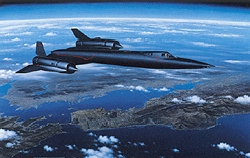|
|
| Way Ahead of its Time |
|
 |

|
 |
|
|
| DESCRIPTION |
 |
| 16 x 11.5 Inch Collector Size Unframed Lithograph $40.00
Aviation artist Stan Stokes has appropriately entitled his outstanding painting of an SR-71 Blackbird as, "Way Ahead of its Time." The Blackbird's origins, amazingly, date back to the 1950's. At that time the U.S. government was very concerned about nuclear developments in the Soviet Union, and a high altitude reconnaissance aircraft was needed to overfly the Soviet Union. The Lockheed Corporation responded by developing the U-2, which was akin to a high powered glider. The U-2 was based on cost effective adaptations of currently available technologies, and was very effective initially, but as surface-to-air missile capability improved, the U-2 became vulnerable. What was needed was a long-range, very fast, very high altitude aircraft, capable of outrunning Soviet surface-to-air missiles. Mr. Kelly Johnson, Lockheed's project engineer who oversaw the famous "skunkworks," presented a proposal to the U.S. government in 1959 regarding the development of a state-of-the-art ultra high speed and ultra high altitude aircraft. The plane, initially designated the A-12, first appeared as the YF-12 interceptor, but the government decided not to fund the YF-12. The design, however, became the SR-71, and the first production Blackbird took to the skies in 1964. The aircraft incorporated many design features never utilized on any aircraft up to that time. For example, at cruising speed the Blackbird's skin would reach nearly 1000 degrees, so the aircraft had to be constructed primarily from a titanium alloy. The SR-71 gets so hot, in fact, that the plane is one foot longer at cruising speed than it is on the ground. For twenty-six years this secretive aircraft held many of the world's records for both speed and altitude. It is believed that about thirty two Blackbirds were produced, and about twenty of these were still in service with the Air Force in 1990. With the development of more capable satellites, and the high cost of maintaining the Blackbird fleet, the Air Force suspended Blackbird operations in 1990. On the final Air Force flight of a Blackbird, from California to Washington, D.C., this incredible aircraft once again set a speed record in making the trip in only sixty-eight minutes. Mr. Stokes has depicted in his painting a SR-71 Blackbird flying at 80,000 feet and at Mach 3.1 over the west coast of the United States. The plane as depicted is piloted by Col. Robert Powell, who is believed to have logged over 1.0 million miles in his 1,020 hours of flight time. Becoming a Blackbird pilot was about as difficult as becoming an astronaut, and Col. Powell personifies the talented and dedicated pioneers, who much like the Blackbird, were way ahead of their time. |
|


|